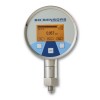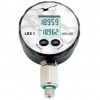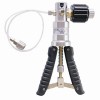Maintain the accuracy of your vacuum sensors, gauges, and switches with high-quality vacuum calibration equipment. Our range includes precision calibration pumps and master gauges designed to generate and measure precise vacuum pressures, ensuring the reliable performance of your vacuum measurement instruments.
 DM01 Multi-Range High Accuracy Pressure Gauge - High precision digital pressure gauge with 0.05% full scale accuracy, exchangeable pressure range modules from 100 mbar (1.5 psi) up to 400 bar (6000 psi).
DM01 Multi-Range High Accuracy Pressure Gauge - High precision digital pressure gauge with 0.05% full scale accuracy, exchangeable pressure range modules from 100 mbar (1.5 psi) up to 400 bar (6000 psi). LEX1 (Ei) High Accuracy Digital Pressure Gauge - High precision digital pressure gauge with an accuracy of 0.05% full scale in pressure ranges from 0...30 mbar up to 0...1000 bar.
LEX1 (Ei) High Accuracy Digital Pressure Gauge - High precision digital pressure gauge with an accuracy of 0.05% full scale in pressure ranges from 0...30 mbar up to 0...1000 bar. PGS40 Mid Pressure Calibration Hand Pump - PGS40 pneumatic hand pump for applying test and calibration pressures with precision from -0.96 up to 40 bar gauge.
PGS40 Mid Pressure Calibration Hand Pump - PGS40 pneumatic hand pump for applying test and calibration pressures with precision from -0.96 up to 40 bar gauge.  +/- 6 psi / 0.4 bar Low Pressure Calibration Pump – ADT901 - The ADT901 low pressure calibration pump is a hand operated pressure pump designed to generate pressures over +/-6 psi (+/-0.4 bar)
+/- 6 psi / 0.4 bar Low Pressure Calibration Pump – ADT901 - The ADT901 low pressure calibration pump is a hand operated pressure pump designed to generate pressures over +/-6 psi (+/-0.4 bar) 60 psi / 4 bar Low Pressure Calibration Pump – ADT912 - Set precise calibration air pressures from 95% vacuum up to 4 bar / 60 psi.
60 psi / 4 bar Low Pressure Calibration Pump – ADT912 - Set precise calibration air pressures from 95% vacuum up to 4 bar / 60 psi.
Find out more about Vacuum Range Calibration Equipment to determine which product options and capabilities will best meet your application requirements.
In the realm of vacuum technology, accurate pressure measurement is paramount for process control, quality assurance, and equipment protection. Vacuum calibration equipment provides the means to verify and adjust the accuracy of vacuum sensors, gauges, and switches, ensuring reliable performance in critical applications.
Calibration Pumps
Calibration pumps are essential tools for generating precise vacuum pressures for calibration purposes. These pumps are designed to evacuate a closed system to a specific vacuum level, allowing technicians to compare the readings of the device under test (DUT) to the known pressure generated by the pump. Key features of calibration pumps include:
- High accuracy and stability: Calibration pumps offer exceptional accuracy and stability in generating vacuum pressures, ensuring reliable calibration results.
- Wide vacuum range: Pumps are available to cover a wide range of vacuum pressures, from rough vacuum to high vacuum, accommodating various sensor types and applications.
- Fine control and adjustment: Precise control mechanisms allow for fine adjustments of the vacuum pressure, enabling accurate calibration across the entire measurement range of the DUT.
Master Gauges
Master gauges serve as the reference standard for accurate vacuum pressure measurement during calibration. These gauges are highly accurate and traceable to national or international standards, providing a reliable benchmark for comparison. Key characteristics of master gauges include:
- Exceptional accuracy and precision: Master gauges offer superior accuracy and precision in vacuum pressure measurement, ensuring reliable calibration results.
- Traceability to standards: Gauges are calibrated against national or international standards, providing confidence in the accuracy of the measurements.
- Wide measurement range: Master gauges are available to cover a wide range of vacuum pressures, accommodating various sensor types and applications.
- Digital displays and data logging: Many master gauges feature digital displays for easy readout and data logging capabilities for record keeping and analysis.
Applications
Partial vacuum calibration equipment plays a crucial role in various industries and applications where accurate measurement and control of vacuum pressures below atmospheric pressure are essential. Here are some key applications:
Industrial Process Control
Many industrial processes rely on partial vacuum conditions to achieve desired outcomes. In vacuum drying, for example, partial vacuum lowers the boiling point of liquids, enabling faster and more efficient drying of heat-sensitive materials like pharmaceuticals and food products. Accurate calibration of vacuum sensors and gauges ensures precise control over the drying process, preventing product degradation and ensuring consistent quality.
Pneumatic Conveying Systems
Vacuum is often used in pneumatic conveying systems to transport items around by picking them up and releasing them. Calibration equipment ensures the accurate measurement of vacuum pressure within the system, optimizing conveying efficiency and preventing blockages or damage to materials.
Vacuum Packaging
Vacuum packaging extends the shelf life of food products by removing oxygen and inhibiting the growth of spoilage microorganisms. Calibration equipment ensures the accurate measurement of vacuum levels within packaging, maintaining product quality and preventing spoilage.
Medical and Laboratory Applications
Vacuum is used in various medical and laboratory applications, such as vacuum filtration, aspiration of fluids, and operation of certain analytical instruments. Calibration equipment ensures the accuracy of vacuum levels in these applications, maintaining the integrity of processes and ensuring reliable results.
HVAC and Refrigeration Systems
Vacuum plays a role in HVAC and refrigeration systems for leak detection and evacuation of refrigerant lines. Calibration equipment ensures the accurate measurement of vacuum levels during these processes, preventing leaks and ensuring efficient system operation.
Automotive Applications
Vacuum is used in automotive applications for various functions, such as brake boosters and emission control systems. Calibration equipment ensures the accurate measurement of vacuum levels in these systems, ensuring optimal performance and safety.
In conclusion, partial vacuum calibration equipment is essential for maintaining accuracy and efficiency in a wide range of industrial, medical, and laboratory applications. By investing in high-quality calibration equipment, organizations can ensure the quality of their products, optimize process efficiency, and ensure safety in critical applications.
